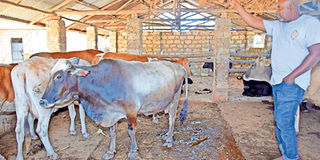Vet on call: The hidden costs in livestock keeping

Suleiman Said with some of his cattle in his farm in Shanzu. Farmers need to note that in any livestock-keeping activity, the cost of maintaining the unproductive animals in the herd is borne by the productive ones. PHOTO | WACHIRA MWANGI | NATION MEDIA GROUP
What you need to know:
- As people invest in livestock at small, medium and large scale levels, they should understand that there are key cost areas they should pay attention to.
- Farmers need to appreciate that the cost of unproductive animals is borne by productive ones.
- The lower limit is achieved when a farm produces most of its feeds or puts the animals on pasture.
- Farmers must also ensure they only employ the minimum number of workers. Ten dairy cattle or less require just one worker, assisted by family labour.
Last week, I got interesting questions from three farmers. Wambura from Kirinyaga asked if she could make money from dairy cattle.
She has 10 Friesian milkers but only gets six litres from every cow daily. She gives her two calves an average of five litres.
Wambura said even if she does not give milk to the calves, her daily production, at Sh40 per litre, is barely sufficient to generate enough to feed, let alone making profit.
Peter from Kajiado has three sows. The animals give him about 10 baconer pigs every 10 months. He sells the slaughter pigs at good prices.
Peter wanted to know why his baconers only give him a marginal profit. He felt that even if he increases the number of pigs, production costs would still leave him with meagre earnings.
Finally, there was Mwangi from Murang’a who is disappointed with his five meat goats. His is considering dropping the “adventure” altogether.
What the three expressed are frustrations that small-scale livestock producers grapple with. Wambura’s case is simply an issue of feeding and managing the cows below the production threshold sufficient to deliver profit. If well-managed, a Friesian cow can give 20 or more litres of milk every day.
She employs two workers. This is unnecessary because one good employee assisted by household labour can take care of 10 cows.
I advised Wambura to feed her cows properly, ensure good management and reduce hired labour. The farmer said she needs at least two people so that one could be left working when the other is unavailable.
Considering her dilemma, I see employment opportunities for the rural folk. Enterprising young people should equip themselves with livestock knowledge. They can thereafter use the skills to get full-time employment on farms or be temporary relievers in times of need.
ECONOMICALLY PRODUCTIVE POPULATION
Peter and Mwangi’s cases are examples of investing in too little stock and missing on the multiplier effect of volume.
This is called economies of scale. When one produces at a high volume, there are savings realised in labour, more efficient use of inputs, among other things. One is also able to buy inputs in large quantities or even at wholesale prices and make savings.
As people invest in livestock at small, medium and large scale levels, they should understand that there are key cost areas they should pay attention to.
Top on the list is the cost of infrastructure and subsequent routine maintenance. These can be frustrating if their nature is not understood from the conception of livestock farming.
Once the infrastructure is built, care must be taken to avoid actions that escalate the need for regular repairs.
I often come across farms where urine, dung and water are not removed for long, resulting in breakdown of pen floors, frequent repairs and illness in animals. This unnecessarily raises the farmer’s cost of production and lowers productivity.
Next is the stocking of the farm with animals and establishing an economically productive population. In livestock farming, there is the number of productive animals required for one to make profit.
Some animals are not productive because of various factors including growing ones such as heifers, bulls and the state of reproduction like pregnancy and sickness.
Farmers need to appreciate that the cost of unproductive animals is borne by productive ones. The larger the unproductive animal population on a farm, the higher the expenses.
MINIMUM NUMBER OF WORKERS
In dairy farming for instance, the ratio of productive to non-productive animals should be between 50 and 60 for every 100.
There was a man who complained about getting nothing from his farm. When I analysed the population, I found that only 70 of his 200 cattle were productive. The others were calves, heifers, repeat breeders and bulls.
We agreed he would sell the bulls and stop rearing them. He also sold repeat breeders that failed to respond to treatment.
Finally, he stopped buying heifers to build his herd and concentrated on transitioning the growing ones into milking cattle.
The farm started realising profits a year after the changes. Feeds are known to comprise zero to 70 per cent of the cost of production in dairy farming.
The lower limit is achieved when a farm produces most of its feeds or puts the animals on pasture. A farmer should always work to minimise the cost of feeding without jeopardising the health of the animals and production.
The other costly item is labour. Every farm is unique in its operations and production methods. It is best when selected workers are trained according to the uniqueness of the farm.
Farmers must also ensure they only employ the minimum number of workers. Ten dairy cattle or less require just one worker, assisted by family labour.





